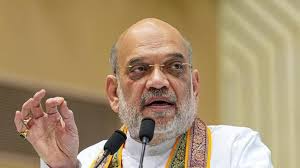Amit Shah says India has become global leader in disaster management

New Delhi, June 16, 2025 — Union Home Minister Amit Shah has declared that India has emerged as a global leader in disaster management, citing the country’s significant achievements over the past decade in building robust systems for disaster preparedness, mitigation, and response. Speaking at the annual conference of disaster response agencies in New Delhi, Shah emphasized that the government’s shift towards a “zero casualty” approach has fundamentally changed India’s disaster management landscape.
A Decade of Transformation
During his keynote address, Amit Shah reflected on how India’s disaster response capabilities have evolved dramatically over the last ten years. According to him, what began as a modest system with basic infrastructure has now become a globally recognized model for rapid, coordinated, and technologically driven disaster response.
“This decade will be remembered as the most transformative period in India’s disaster management history,” Shah said. “From depending on foreign aid and slow responses, we now deploy world-class rescue teams, make use of cutting-edge technology, and coordinate efforts with unparalleled efficiency.”
Zero Casualty Goal: A Policy Shift
One of the most significant changes highlighted by Shah was the government’s deliberate shift from a “minimum casualty” goal to a more ambitious “zero casualty” policy. He stressed that every human life is invaluable, and no disaster, whether natural or man-made, should result in avoidable loss of life.
The minister credited this policy shift to India’s enhanced forecasting systems, community training programs, and the integration of advanced technology in early warning mechanisms.
Strengthening Institutions
Amit Shah lauded the pivotal roles played by organizations like the National Disaster Management Authority (NDMA) and the National Disaster Response Force (NDRF). These institutions, according to him, have been at the forefront of India’s disaster management evolution.
The NDMA has spearheaded initiatives in capacity building, policy planning, and infrastructure development. The NDRF, with its specialized battalions and extensive training modules, has conducted thousands of successful rescue and relief operations across flood-hit areas, earthquake zones, and during cyclonic storms.
Moreover, India’s leadership in the Coalition for Disaster Resilient Infrastructure (CDRI) has allowed it to play a proactive role on the international stage. Launched by Prime Minister Narendra Modi in 2019, CDRI brings together countries and organizations to promote resilient infrastructure systems.
Technological Leap and Digital Preparedness
In his address, Shah also emphasized how technology is now at the heart of India’s disaster management strategy. From GIS-based risk mapping and AI-powered early warning systems to mobile apps that alert communities about imminent threats, India has embraced innovation to reduce vulnerabilities.
He urged authorities at the state and district levels to fully implement and maintain District Disaster Management Plans (DDMPs) within 90 days. These blueprints are vital for real-time decision-making during emergencies and must include provisions for local infrastructure, hospitals, communication networks, and evacuation routes.
Community Engagement and Resilience
Recognizing that disaster response must begin at the grassroots, Shah underscored the importance of community participation. He called for the training of at least one person in every village as a disaster response volunteer, especially in vulnerable regions.
“The community is our first responder. We must empower every citizen with the knowledge and tools to save lives,” he said.
In addition, Shah proposed integrating startups and innovators into disaster management ecosystems. Many Indian startups are already developing low-cost drones, flood prediction models, and mobile-based coordination tools. Shah believes that supporting such innovations will enhance both the speed and precision of future responses.
From Follower to Leader
Amit Shah’s declaration comes at a time when India is actively assisting other nations during crises. The “Operation Dost” mission, during which India sent rescue teams and medical aid to Turkey after the 2023 earthquake, was widely praised by international communities. India has also helped neighboring countries like Nepal, Bangladesh, and Sri Lanka in times of flooding and landslides.
This international cooperation has reinforced India’s image as not just a nation protecting its own, but one extending a helping hand globally.
Training, Preparedness, and Investment
The government has invested heavily in training programs for police, paramilitary forces, and local governance bodies. Simulations, mock drills, and annual training events are now standard procedures in many parts of the country.
The Central government’s National Cyclone Risk Mitigation Project (NCRMP) and Flood Management Programme (FMP) have further strengthened India’s resilience in coastal and flood-prone areas.
Financially, disaster management budgets have grown significantly. Dedicated funds like the State Disaster Response Fund (SDRF) and National Disaster Response Fund (NDRF) now provide faster relief packages and better rehabilitation infrastructure.
A Roadmap for the Future
While celebrating the achievements, Shah also laid out a vision for the future:
- Integration of real-time satellite data with local-level monitoring.
- Promotion of disaster-resilient infrastructure in urban planning.
- Expansion of school and college-level disaster preparedness education.
- Establishing permanent regional disaster hubs in vulnerable zones.
He encouraged all state governments to align their policies with national disaster resilience goals and maintain strict accountability at every administrative level.
Conclusion
India’s journey from a reactive nation to a proactive global leader in disaster management has been marked by policy innovation, technological advancement, and a deep commitment to saving lives. Amit Shah’s speech not only highlights these milestones but also offers a blueprint for future resilience.
As climate change increases the frequency and intensity of disasters worldwide, India’s model could inspire many developing nations to rethink their strategies and prioritize preparedness over response.






